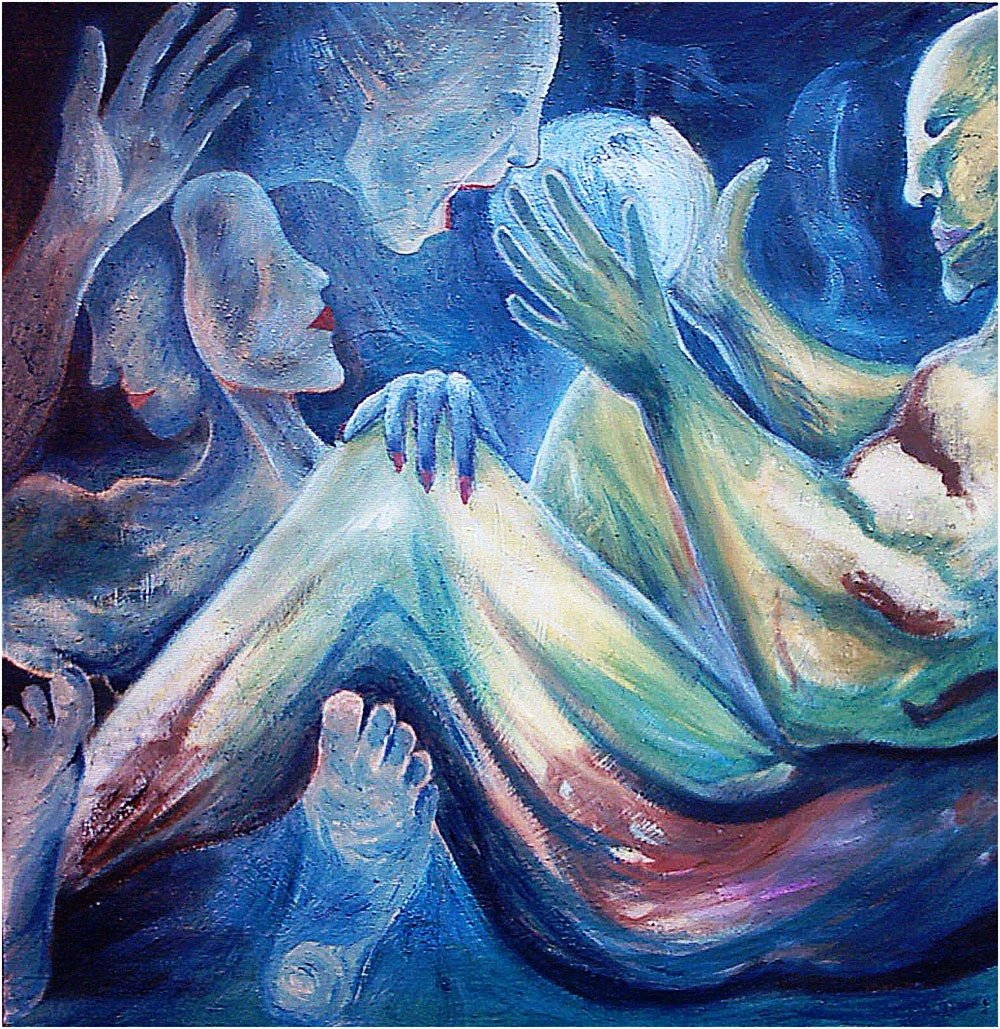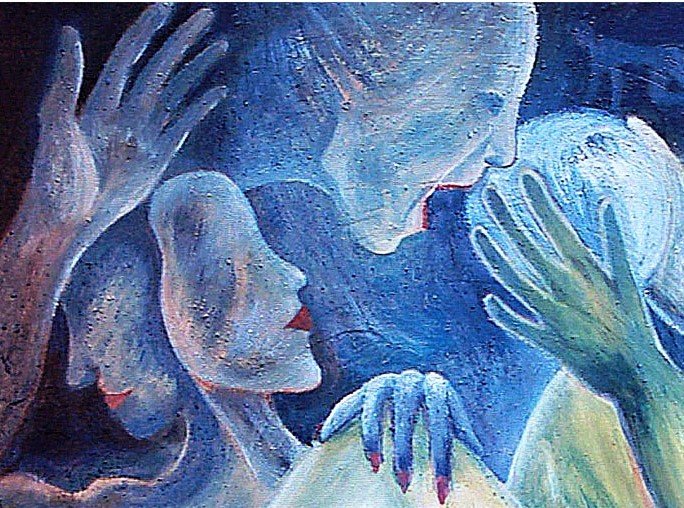
the myth of eternal love

2 0 1 8
oil and cement on canvas

Selene.
Its name in Greek means Luna, and the resplendent.
It is therefore the goddess of the Moon, but also the most elusive and mysterious female divinity of Olympus.
Although her presence is not very common in mythological stories, she represents the object of desire of male gods, her cosmogonic image is associated with the full moon.
She is represented as a very young woman, on a silver horse-drawn carriage in the night sky.
Selene was the elusive and mysterious goddess that all the male divinities of Olympus wanted to conquer including the usual Zeus, from which Selene had a daughter, Pandia, according to a very accredited version from the mythologists from the relations with Zeus it seems that Selene also had Erse, the dew.
But back to love with Endymion, the myth that has aroused the interest of the greatest artists, writers and musicians in history.
The myth of eternal love!
In the multitude of stories of the Pantheon, Selene is the protagonist on one occasion: in the myth of Endymion, the beautiful king of Elis, of whom the goddess had fallen madly in love.
Elide the king of the shepherds, he lived in a cave, and Selene saw the beautiful young man sleeping in a cave and fell in love with him, returning to visit him every night.
To meet him at night he disappeared behind a mountain, and so the Greeks explained the natural phenomenon of the descent of the Moon and the darkness of the night.
Selene then, madly in love with the pastor, introduced herself to Zeus with two requests;
- to marry his Endymion
- to make it immortal.
Zeus consented, knowing that the goddess had forgotten to ask her eternal youth for her future husband.
At the sight of Endymion's first white hair, Selene was tormented by the idea of losing her beloved forever and made a decision, according to Hypnos (the god of sleep) kissed the eyelids of his love and made him sleep forever, preserving him from the breakup of his body.
This dramatic story, romantic and sad at the same time, helps us with a question that we often ask ourselves; Can eternal love exist?
Well, a new scientific theory, that a group of researchers from the University of Arizona is conducting shows yes!
The publication in the American journal Psychological Science based on an analysis and research done on 80,000 couples from 18 countries in the world, reveals that love can not be broken even after death, and our loved ones continue to influence our life even after the loss of our beloved.
Here is a very interesting statement by Kyle Bourassa at the head of the project:
What we want to know is this: just think of your partner enough to create interdependence?, If so, how could we use this information to better help those who have lost a spouse?. source
Myth and Science, lunar union!
Greetings from the Pantheon.
Armando

detail

Selene.
Il suo nome in greco significa Moon, e la risplendente.
E' quindi la dea della Luna, ma anche la più sfuggente e misteriosa divinità femminile dell'Olimpo.
Nonostante la sua presenza non sia molto diffusa nei racconti mitologici, ella rappresenta l'oggetto del desiderio degli dei maschili, la sua immagina cosmogonica è associata alla luna piena.
E' rappresentata come una donna molto giovane, su una carro d'argento trainati da cavalli nello spazio notturno del cielo.
Selene era la dea inafferrabile e misteriosa che tutte le divinità maschili dell'Olimpo volevano conquistare compreso il solito Zeus , dal quale Selene ebbe una figlia, Pandia, secondo una versione molto accreditata dai mitologi dai rapporti con Zeus pare che Selene abbia avuto anche Erse, la rugiada.
Ma torniamo all'amore con Endimione, il mito che ha suscitato l'interesse dei più grandi artisti, letterati e musicisti della storia.
Il mito dell'amore eterno!
Nella moltitudine di storie del Pantheon, Selene è protagonista in una sola occasione: nel mito di Endimione, il bellissimo re dell'Elide, del quale la dea si era perdutamente innamorata.
Elide il re dei pastori, viveva in una grotta, e Selene vide il bellissimo giovane dormire in una grotta e si innamorò di lui, tornando a visitarlo ogni notte.
Per incontrarlo di notte spariva dietro un monte, e così i greci spiegavano il fenomeno naturale della discesa della Luna e il buio della notte.
Selene allora, innamorata follemente del pastore, si presentò a Zeus con due richieste;
- di sposare il suo Endimione e
- di farlo diventare immortale.
Zeus acconsentì, ben sapendo che la dea si era dimenticato di chiedere, per il suo futuro sposo, anche l'eterna giovinezza.
Alla vista dei primi capelli bianchi di Endimione, Selene fu tormentata dall'idea di perdere per sempre il suo amato e prese una decisione, in accordo con Hypnos (il dio del sonno) baciò le palpebre del suo amore e lo fece dormire per sempre, conservandolo dal disfacimento del suo fisico.
Questa drammatica storia, romantica e triste allo stesso tempo, ci viene a supporto per una domanda che spesso ci poniamo; può esistere l'amore eterno?
Ebbene una nuova teoria scientifica, che un gruppo di ricercatori dell'Università dell'Arizona sta conducendo dimostra di si!
La pubblicazione sulla rivista americana Psychological Science basata su un'analisi e ricerca fatta su 80.000 coppie di 18 Paesi nel mondo, rivela che l'amore non può essere spezzato neanche dopo la morte, e i nostri cari continuano ad influenzare la nostra vita anche dopo la perdita del nostro amato.
Riporto un'affermazione molto interessante di Kyle Bourassa a capo del progetto:
Quello che vogliamo sapere è questo: basta pensare al tuo partner abbastanza per creare l'interdipendenza?. In caso affermativo, come potremmo usare queste informazioni per aiutare meglio coloro che hanno perso il coniuge?.source
Il Mito e la Scienza, unione lunare!
Un saluto dal Pantheon.
Armando



- Art teacher
- Curator of cultural activities
- Artistic director and President of the Cultural Association "I Colori della Vita"

